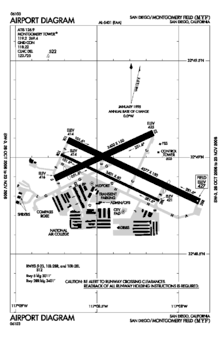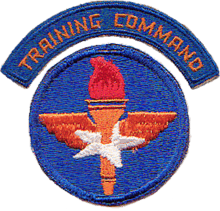Montgomery-Gibbs Executive Airport
| Montgomery - Gibbs Executive Airport Gibbs AF Auxiliary Field | |||||||||||||||||||
|---|---|---|---|---|---|---|---|---|---|---|---|---|---|---|---|---|---|---|---|
 | |||||||||||||||||||
| Summary | |||||||||||||||||||
| Airport type | Public | ||||||||||||||||||
| Operator | City of San Diego | ||||||||||||||||||
| Location | San Diego, California | ||||||||||||||||||
| Elevation AMSL | 427 ft / 130.1 m | ||||||||||||||||||
| Coordinates | 32°48′57″N 117°08′22″W / 32.81583°N 117.13944°WCoordinates: 32°48′57″N 117°08′22″W / 32.81583°N 117.13944°W | ||||||||||||||||||
| Runways | |||||||||||||||||||
| |||||||||||||||||||
| Helipads | |||||||||||||||||||
| |||||||||||||||||||


Montgomery - Gibbs Executive Airport (IATA: MYF, ICAO: KMYF, FAA LID: MYF) is a public airport in San Diego, California, United States, six miles (10 km) north of downtown San Diego. The airport covers 456 acres (185 ha) and has three runways, one public and two private helipads. The runways are 28 Right/10 Left-28 Left/10 Right parallels and 5/23.
Overview
The field was named for John J. Montgomery, an aviation pioneer who in 1884-1886 made the first manned, controlled, heavier-than-air flights in the United States from Otay Mesa south of San Diego starting with a glider designed in 1883.[1] and for William Gibbs 1910-2016 who founded the airport in 1940. Montgomery - Gibbs Executive Airport is one of the nation's busiest airports for small aircraft and has a number of flying clubs, flight schools, plus business turboprops and jets based there. The San Diego Fire Department bases aircraft there. King Schools, Inc. is based nearby and its aircraft are based at the airport. Since summer 2009, King Schools (in conjunction with Cessna) has been flight-testing the prototype Cessna 162 Skycatcher Light-Sport Aircraft at or around the airport. The airport was renamed Montgomery - Gibbs Executive Airport in 2016[2]
History
The airport opened in July 1940 as "Gibbs Field" as an all-way clay and gravel surface airfield. During World War II, control of the airport was assumed by the United States Army Air Forces, which built three hard runways. It was called "Gibbs Auxiliary Field" and used as a support airfield for the contractor pilot school at Ryan Field, near Hemet. It also supported training activities at the United States Army Desert Training Center (DTC) in the Mojave Desert, and later as an auxiliary airfield for Lindbergh Field in San Diego. It was used presumably as an overflow airfield to store newly manufactured B-24 Liberator bombers and PBY Catalina amphibian aircraft made by Consolidated Aircraft.
After the war the airport returned to civil control. The airport was renamed Montgomery Field in 1950 to honor John J Montgomery. The Federal Aviation Administration has maintained an Air Traffic Control Tower at the airport since 1965. It is on the north side of the airport, just east of Taxiway C and Runway 23/5, and the normal hours are 0600-2100 Local Time.
Accidents and incidents
- On September 25, 1978 a Cessna 172 N7711G took off from Montgomery Field and proceeded to Lindbergh Field to do a practice instrument landing (ILS) approach. PSA Flight 182 (N533PS) was heading east on its downwind descent before landing at Lindbergh. The PSA Boeing 727 hit the Cessna from behind, causing N7711G to disintegrate and flight 182 to crash.[3][4][5]
- On February 17, 1983, a Piper 601P registered as N90353 crashed shortly after takeoff, killing all five aboard.[6]
- On November 11, 1983, a Beech 56TC registered as N911SC collided with power lines while landing. The aircraft caught on fire and crashed, killing all four aboard.[7]
- On May 17, 1990, a Cessna 152 registered as N783G stalled on final approach and abruptly crashed. The student pilot, flying solo, was killed.[8]
- On December 24, 1996, a Piper PA-28 registered as N943R collided with a Cessna 150 (N63137) while the two aircraft were making their final approaches to parallel runways. The aircraft failed to maintain visual separation and the low-wing Piper overtook the high-wing Cessna from behind and above. The Piper's control cables were severed by the Cessna's propeller and it crashed, killing both the student pilot and flight instructor. The Cessna made a forced landing, and both occupants survived.[9]
- On February 19, 2010 a Cirrus SR-22 Turbo Gen-3 registered as N443CP, was stolen from Montgomery Field and proceeded to Los Angeles International Airport.
- On August 2, 2010 N444YP, an experimental Velocity Super XL, crashed into a golf course shortly after takeoff at Montgomery Field, killing two of the five aboard.[10][11]
- On March 2, 2014 a Mooney M20S Eagle, N56FM, sustained minor damage after a gear-up landing. The sole occupant, the pilot, was uninjured in the incident.[12]
- On July 30, 2014 a Mooney M20L, N147MP, crashed in an adjacent shopping center parking lot after a failed go-around at Montgomery Field. Of the two occupants on board, the passenger was killed and the pilot was seriously injured.[13]
- On December 9, 2017, a Beechcraft Bonanza with four people on board crashed shortly after takeoff from Montgomery Field. The pilot and a passenger survived with burn injuries while the two other passengers were killed.[14]
See also
References
![]()
- ↑ Harwood, Craig; Fogel, Gary (2012). Quest for Flight: John J. Montgomery and the Dawn of Aviation in the West. Norman, Oklahoma: University of Oklahoma Press. ASIN 0806142642.
- ↑ http://timesofsandiego.com/politics/2016/01/12/city-votes-renames-montgoemery-field-to/
- ↑ "NTSB Identification DCA78AA023". National Transportation Safety Board. 25 September 1978. Retrieved 19 August 2017.
- ↑ Accident description for PSA N533PS at the Aviation Safety Network. Retrieved on 19 August 2017.
- ↑ "ASN Wikibase Occurrence # 6671". Aviation Safety Network. 25 September 1978. Retrieved 19 August 2017.
- ↑ "NTSB Identification LAX83FA104". National Transportation Safety Board. 17 February 1983. Retrieved 19 August 2017.
- ↑ "NTSB Identification LAX84FA058". National Transportation Safety Board. 11 November 1983. Retrieved 19 August 2017.
- ↑ "NTSB Identification LAX90FA179". National Transportation Safety Board. 17 May 1990. Retrieved 19 August 2017.
- ↑ "NTSB Identification LAX97FA075A". National Transportation Safety Board. 24 December 1996. Retrieved 19 August 2017.
- ↑ "NTSB Identification WPR10LA381". National Transportation Safety Board. 2 August 2010. Retrieved 19 August 2017.
- ↑ "ASN Wikibase Occurrence # 76019". Aviation Safety Network. 2 August 2010. Retrieved 19 August 2017.
- ↑ "ASN Wikibase Occurrence # 164447". Aviation Safety Network. 2 March 2014. Retrieved 19 August 2017.
- ↑ "ASN Wikibase Occurrence # 168168". Aviation Safety Network. 30 July 2014. Retrieved 19 August 2017.
- ↑ Davis, Kristina; Repard, Pauline; Wilkens, John. "Plane crashes into Clairemont home, killing 2 passengers". San Diego Union-Tribune. Retrieved 9 December 2017.
- www.airfieldsdatabase.com
- FAA Airport Master Record for MYF (Form 5010 PDF)
- Harwood, Craig S. and Fogel, Gary B. Quest for Flight: John J. Montgomery and the Dawn of Aviation in the West, University of Oklahoma Press 2012.
External links
- FAA Airport Diagram (PDF), effective October 11, 2018
- Resources for this airport:
- FAA airport information for MYF
- AirNav airport information for KMYF
- ASN accident history for MYF
- FlightAware airport information and live flight tracker
- NOAA/NWS latest weather observations
- SkyVector aeronautical chart, Terminal Procedures
- Montgomery-Gibbs Executive Airport
- San Diego history in airports
